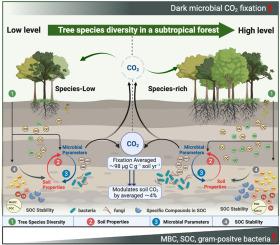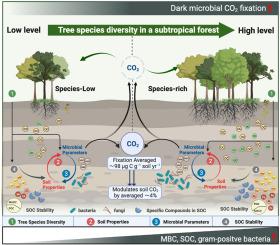Tree species diversity enhances dark microbial CO2 fixation rates in soil of a subtropical forest
IF 10.3
1区 农林科学
Q1 SOIL SCIENCE
引用次数: 0
Abstract
Tree species diversity (TSD) is crucial for modulating microbial processes and enhancing soil organic carbon (SOC) accumulation in forest ecosystems. However, the role of TSD in regulating dark microbial CO2 fixation (DMCF), a key microbial pathway contributing to SOC formation, remains largely unexplored. Here, we conducted a13C–CO2 labeling experiment across three CO2 concentrations (2 %, 5 %, and 15 %) using soils from a gradient of TSD (Shannon index 0.15–3.57) in a subtropical forest. Our results revealed that DMCF rates averaged 0.27 μg C g−1 soil day−1 and 174.39 μg C g−1 MBC day−1, offsetting 0.67 %–6.16 % of total soil CO2 emissions in a subtropical karst forest. DMCF rates were positively correlated with TSD at both 2 % and 5 % atmospheric CO2 concentrations. In contrast, this positive relationship disappeared under 15 % CO2, where DMCF rates peaked at intermediate TSD, suggesting a potential stress-induced decoupling. TSD influenced DMCF through its effects on soil properties, microbial communities, and SOC stability. Microbial biomass carbon and the abundance of gram-positive bacteria were identified as key drivers of DMCF, underscoring the significance of microbial community composition in regulating DMCF rates. These findings highlight the often-overlooked contribution of DMCF to SOC storage in subtropical forests and emphasize the role of TSD in enhancing SOC sequestration. This study provides novel insights into the mechanisms governing DMCF, challenging the assumption that biodiversity consistently enhances ecosystem functions under extreme climatic drivers.


树种多样性提高了亚热带森林土壤中暗微生物的CO2固定率
树种多样性(TSD)是调节森林生态系统微生物过程和提高土壤有机碳(SOC)积累的关键。然而,TSD在调节暗微生物二氧化碳固定(DMCF)中的作用,这是促进有机碳形成的关键微生物途径,在很大程度上仍未被探索。在这里,我们使用来自亚热带森林TSD (Shannon指数0.15-3.57)梯度的土壤,在三种CO2浓度(2%、5%和15%)下进行了13C-CO2标记实验。结果表明,亚热带喀斯特森林DMCF平均速率为0.27 μ C g-1土壤d -1和174.39 μ C g-1 MBC d -1,抵消了土壤CO2总排放量的0.67% ~ 6.16%。在大气CO2浓度为2%和5%时,DMCF率与TSD呈正相关。相比之下,当二氧化碳浓度为15%时,这种正相关关系消失,DMCF率在中等TSD时达到峰值,这表明可能存在应力诱导的脱钩。TSD通过影响土壤性质、微生物群落和有机碳稳定性来影响DMCF。微生物生物量碳和革兰氏阳性菌丰度被确定为DMCF的关键驱动因素,强调了微生物群落组成在调节DMCF速率中的重要性。这些发现突出了DMCF对亚热带森林有机碳储存的贡献,并强调了TSD在增强有机碳固存中的作用。这项研究为DMCF的控制机制提供了新的见解,挑战了生物多样性在极端气候驱动下持续增强生态系统功能的假设。
本文章由计算机程序翻译,如有差异,请以英文原文为准。
求助全文
约1分钟内获得全文
求助全文
来源期刊

Soil Biology & Biochemistry
农林科学-土壤科学
CiteScore
16.90
自引率
9.30%
发文量
312
审稿时长
49 days
期刊介绍:
Soil Biology & Biochemistry publishes original research articles of international significance focusing on biological processes in soil and their applications to soil and environmental quality. Major topics include the ecology and biochemical processes of soil organisms, their effects on the environment, and interactions with plants. The journal also welcomes state-of-the-art reviews and discussions on contemporary research in soil biology and biochemistry.
 求助内容:
求助内容: 应助结果提醒方式:
应助结果提醒方式:


